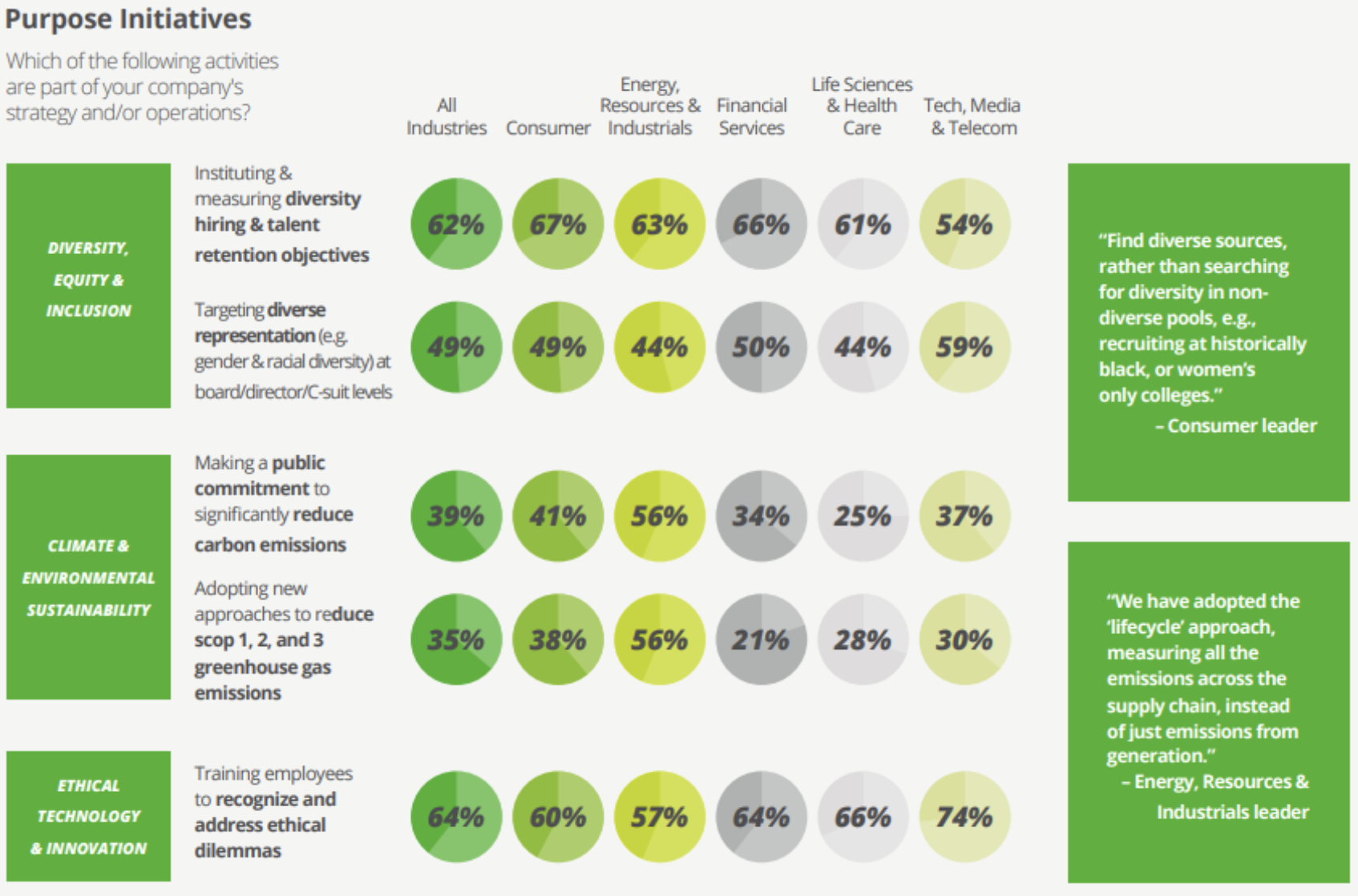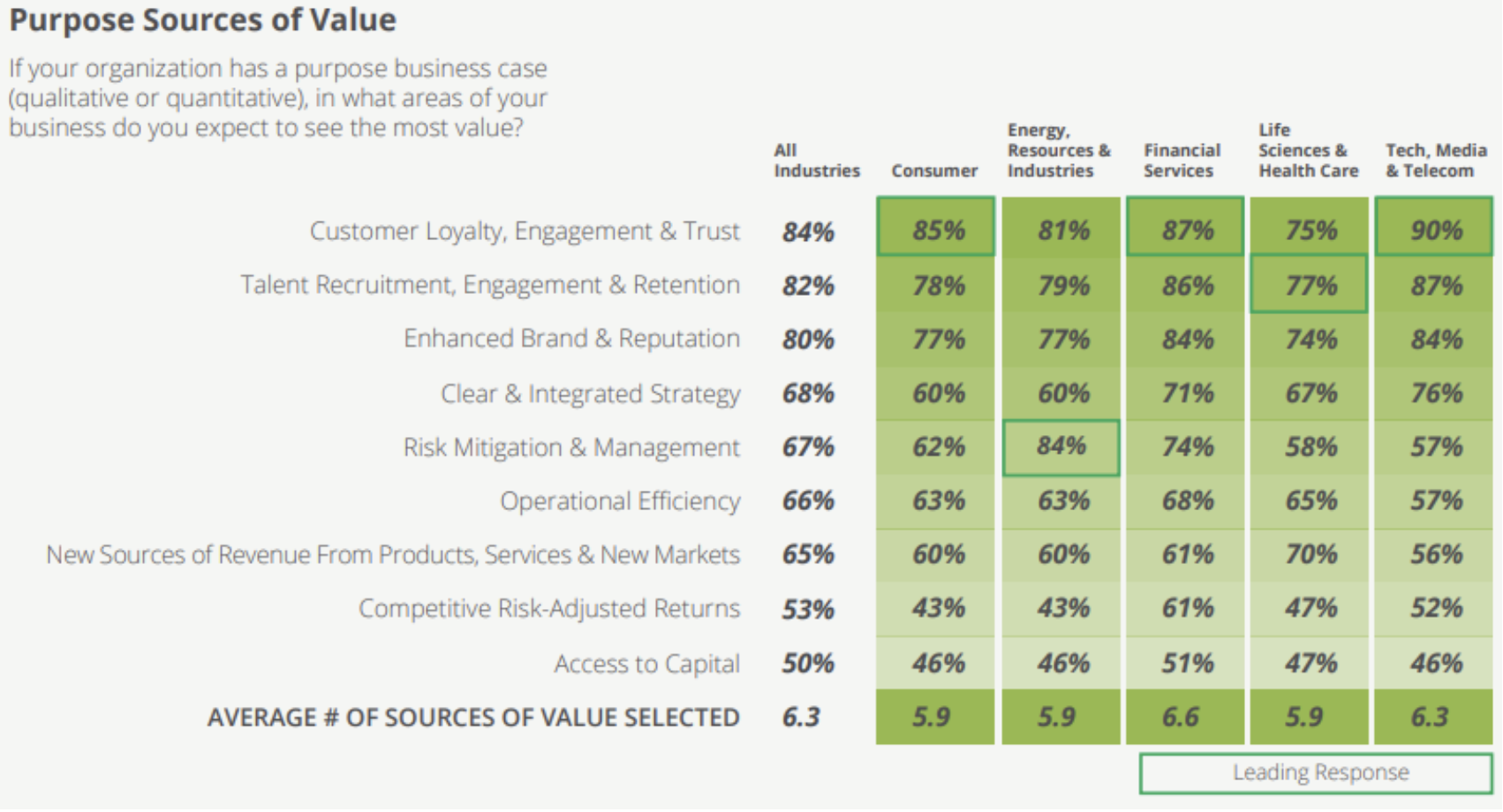by John Mennel and Shira Beery and John Peto*
Purpose is a company’s reason for being, and its distinctive role in society. It has become an important factor in consumer, investor, and employee decisions and a common topic on boardroom and regulatory agendas. In one recent study, 28% of consumers said they had stopped buying a particular product or products, based on ethical or environmental concerns. 73% of investors believe that a company’s social and environmental efforts contribute to returns. Recent market performance validates this belief with environmental, social, and governance (ESG) funds outperforming the S&P 500 companies in early 2021.
Other terms – sustainability, responsibility, or stakeholder capitalism – may be used to convey the same concept: to protect profit and stakeholder value, a company should credibly demonstrate its unique positive impact on people and planet. It can be hard for business leaders to know what to do or where to start, but insufficient action to demonstrate organizational purpose can increase risks and costs for companies.
Demonstrating organizational purpose
Deloitte surveyed 400 business leaders representing different industries to find out whether, why, and how their company prioritizes purpose. Our analysis of the survey results finds that while companies in each industry appear to have relative strengths and gaps in this area, companies across industries share the following common opportunities to demonstrate purpose:
1. Walk the talk on organizational purpose
A significant proportion – 43% - of business leaders say their company views organizational purpose exclusively as a marketing and brand play. These respondents are much more likely to report that purpose does not get adequate attention at their company (52% vs. 23%). This approach carries risks. Organizations face costs when they fail to meet the expectation that they act in line with their purpose, including loss of brand trust and increased legal action. And employees may leave a company when management’s stance does not align with their values.
The organizations most frequently mentioned as purpose leaders by survey respondents demonstrate this through core business activities. Executives should move toward an active purpose strategy; it should be driven by the CEO, informed by best practice and standards, and embedded in all aspects of operations with an eye to long-term value and impact. Companies should rethink their core business strategy, including product design and delivery, use of technology and data, brand messaging, employee, and community engagement, and more through a unifying purpose framework.
2. Act on the most important issues
No two industries, companies, or approaches to organizational purpose are exactly alike. Some ESG issues may be more important or relevant to a given company. For example, an issue might impact the organization’s financial condition or valuation, or the lives of its stakeholders; or the organization might have a significant impact on the issue. While some issues are common across multiple industries, others are significantly more relevant to specific industries.
A strong organizational purpose strategy identifies a company’s most important issues and establishes a holistic, differentiated approach to address them. Companies that do this effectively see premium returns. While individual companies are spending up to tens of billions on purpose-related investments, surveyed business leaders reveal a notable degree of inaction on important issues. For example, among the business leaders who identify diversity, equity and inclusion as a top-three issue for their sector, only 68% report that their company is instituting and measuring hiring and retention objectives to that end.

3. Be proactive about measuring impact
Ultimately, a company will not invest in its purpose if it does not increase profitability. Most business leaders (82%) say that the primary focus of their company’s purpose strategy is to create business value. Respondents whose companies have a rigorous, data-driven business case for organizational purpose are more likely to report a broader range of expected sources of value, including increased revenue from products, services, and new markets. When asked what would help strengthen the business case to drive more significant investment toward purpose initiatives, respondents across industries overwhelmingly say they need better data, specifically on the impact of business operations on social and environmental issues.
Many companies are waiting for standards and frameworks to guide their measurement and reporting. However, business leaders should not wait and can even influence the way those standards are shaped, especially on social metrics, by proactively measuring ESG impact. Companies should first use existing measurement systems and approaches to collect data on their performance against purpose priorities. Business leaders can establish a scorecard that includes the key decisions informed by organizational purpose initiatives and how these have added value.

4. Look beyond your industry
More than half of business leaders say that purpose does not get adequate attention in their industry. Today’s social, economic, and geopolitical uncertainty can make it difficult to commit to organizational purpose strategy and action.
Connecting the dots across disciplines and sectors can make companies more resilient and spark new ideas. Companies can increase their impact through cross-sector collaboration. For example, the World Economic Forum launched the Global Health Equity Network with over 20 organizations spanning a variety of industries, recognizing that addressing health equity and racism as a public health crisis will require cross-sector collaboration. Efforts like these help organizations across industries and locations share best practices and make contributions toward a greater collective impact.
The message from stakeholders is loud and clear: business leaders have a responsibility to advance a more sustainable and equitable future, and companies that are not a credible part of the solution will see their bottom line suffer. Companies will help unlock premium value for their enterprise and its stakeholders as the organization makes a unique, positive impact.
*Managing Director, Purpose, ESG & Sustainability Leader, Deloitte and Senior Manager, Purpose, ESG & Sustainability, Deloitte and Principal, Head of Consulting Sustainability, Deloitte
**first published in: Weforum.org




 By: N. Peter Kramer
By: N. Peter Kramer
